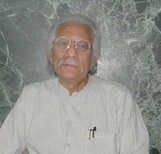Receive Our Newsletter
For news of readings, events and new titles.

Ahmed Morsi was born in Alexandria, Egypt in 1930 and grew up there. After graduating in English Literature, and publishing his first poetry collection at the age of 19, he went to study art in the Alexandria studio of Silvio Becchi. From early on, he became a part of Alexandria’s literary and artistic society and by his early twenties was showing his works in group exhibitions with Egypt’s most notable modern artists, including A Al Gazzar, H El Telmisani, I Massouda, F Kamel, H Nada and M Moussa. He was one of the few handpicked artist selected to exhibit at the opening of the city’s Museum of Fine Arts.
Amhed Morsi lived for two years in Baghdad, from 1955 to 1957, which was a time when Iraq was experiencing a cultural renaissance and Baghdad was a literary, artistic and intellectual hub. There he developed lifelong friendships and working creative relationships with Iraqi writers and painters, among them Abdel Wahab Al Bayati, Fuad Al Takarli and Ardash Kakavian. He was also able to nurture his talent for art criticism and wrote on major Baghdadi exhibitions for local newspapers.
Back in Egypt, he lived in Cairo, working alongside acclaimed playwrights Alfred Farag and Abdel Rahman Al Sharkawi, designing stage sets and costumes for The National Theatre and the original, Khedieval, Cairo Opera House. In 1968, he co-founded the avant-garde magazine Gallery 68 with Egyptian authors Edwar Al Kharrat, Ibrahim Mansour, Gamil Atteya, Sayed Hegab and others, and served as its Editor-in-Chief. Gallery 68 became the voice of the new modernism and Ahmed Morsi began to publish a number of critical articles on both art and literature. In his 1995 show, he pioneered a new creative vehicle, “The Artist’s Book”, that led to a new biennial exhibition, The Artist’s Book, being established in Alexandria, under the auspices of the Biblioteca Alexandrina.
In 1974, Ahmed Morsi moved to New York City, where he continues to paint and write. In 1976, like many other artists in NYC, he took up printmaking, adding yet another string to his creative bow, and in the last 20 years embraced photography.
Contributor's Issues